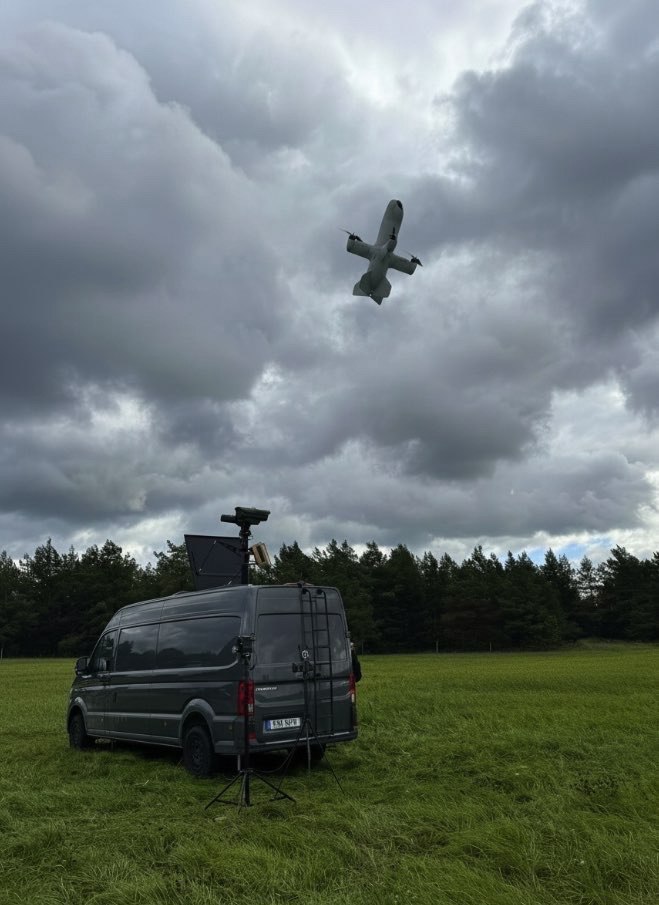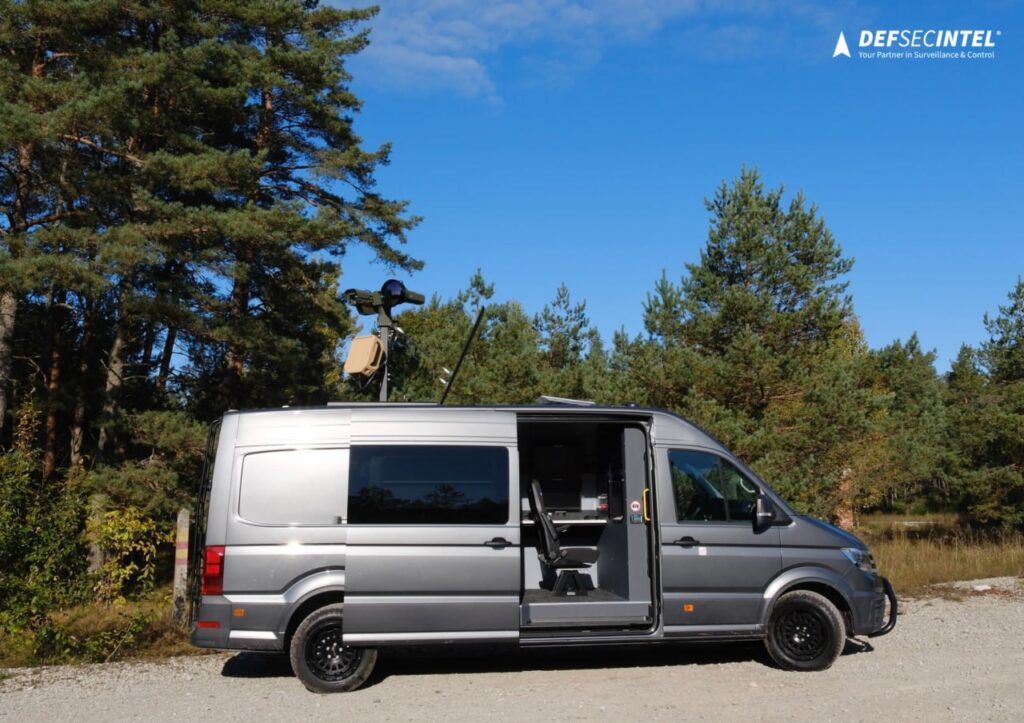Europe is struggling with drones flying too low for traditional radars to detect, but an Estonian company says it has found the solution. In an exclusive interview given for BANI.MD, Jaanus Tamm, CEO of DefSecIntel, explains how the EIRSHIELD system can detect Shahed drones below 100 meters, why Moldova is “completely unprotected” against such threats, and how technology battle-tested in Ukraine could provide real defence within just a few months.
1. Your systems can reportedly detect Shahed drones flying as low as 100 meters. How does DefSecIntel achieve this level of precision where traditional radar often fails?
Yes, Eirshield has unique capabiliteis for low altirude Flying drones. It is important to understand that traditional air-defence radars are optimised for high-altitude, high-signature targets. Low-cost kamikaze drones like Shaheds fly low, slow and with small radar cross-sections, which makes them extremely difficult to track with traditional legacy systems.
DefSecIntel achieves high-precision low-altitude detection through a multi-sensor fusion architecture, not radar alone. Different drones are requiring different options for detection. Additionally we have visual cameras-based verification of detection.

Defsecintel Solutions turn-key C-UAS EIRSHIELD combines:
- Mid-range 3D radar optimised for low-signature targets
- RF/SIGINT direction finding (detecting command links, GNSS manipulation, emissions)
- EO/IR automatic tracking and verification/classification
- Acoustic arrays tuned for drone motor signatures
- AI-driven correlation, which merges all these inputs into one track
This allows the system to detect and classify drones flying below 100 meters, even in cluttered terrain where classic radar loses coverage. The system was specifically designed based on the lessons learned from Ukraine, and to fill the “low-altitude gap” that Europe struggles with.
2. DefSecIntel entered Ukraine in 2022. What were the biggest operational challenges your technology faced in an active warzone, and how did they shape current solutions?
Defsecintel started in 2018 developing mobile autonomous surveillance systems – equipped with AI-powered C2 – for border guards. Back then there was a migration crisis and we went to help the Lithuanian border guards. We had operational experience from different countries homeland security end-users before the full-scale war in Ukraine started and we established presence there in 2022. We have at the moment there small factory, maintenance and R&D Hub.
Ukraine presented us with real combat conditions, not simulations. The main challenges included:
- Intense electronic warfare (EW) interfering with radar, RF and GNSS
- Very low-flying FPV and Shahed-type drones
- Rapidly changing threat profiles every few weeks
- Operator overload under time pressure
- Need for extreme mobility to survive counter-battery fire
These challenges shaped our systems, including EIRSHIELD into a system that is:
- AI-assisted, reducing operator workload
- Designed with automated sensor cueing and track fusion
- Built for high EW resistance
- Fully mobile and all-terrain, deployable within minutes
- Modular, allowing new effectors and sensors to be integrated quickly
- Cost-effective
Situation in Ukraine made us to build a practical, robust, combat-proven platform rather than a laboratory prototype. Strong presence in Ukraine has given real-time feedback and opportunity to increase our rapid development cycle, test and use solutions in the battlefield or operational level, and expereince. We have taken input from Ukraine experience to develop systems for European end-user needs, including for the border security, critical infrastructure protection, defence, and for peacetime (e.g. C-UAS solutions in peacetime).

3. Low-cost kamikaze drones have changed modern warfare. How has DefSecIntel adapted its sensor and AI system to counter this threat?
Our approach is based on three adaptations:
1. Multi-layer detection
No single sensor can reliably detect modern drones. We integrated radar, acoustic, RF, EO/IR and AI classifiers into one fused system.
2. AI-driven classification & tracking
AI models trained on real data allow the system to:
- Distinguish drones from birds
- Track “low, slow, small” targets
- Predict flight paths
- Trigger automated effector handover
3. Flexible affordable kill-chain
Different drones require different effectors to eliminate. EIRSHIELD supports:
- EW jamming
- RF/GNSS disruption
- AI-guided interceptor drones
- Optional kinetic interceptors
This ensures effective protection against both cheap FPVs and long-range Shahed-type drones etc.
4. Many countries struggle with low-altitude detection. Can your system realistically fill this gap, and what infrastructure is required?
Yes. EIRSHIELD was built specifically to close the low-altitude gap.
It requires much lighter infrastructure than classic radar sites. A minimal deployment includes:
- 1× mobile EIRSHIELD C-UAS unit (sensors + effectors integrated, depends of the end-user requirement)
- Optional mast/tower-mounted radar + RF sensors for fixed sites
- C2 integration with national air-surveillance networks.
- Launcher platform for different effectors.
For border regions, systems can be deployed in:
- Autonomous clusters
- Networked sector grids
- Cross-border fusion layers, such as the Drone Wall concept
EIRSHIELD provides persistent low-altitude coverage without the cost of traditional air-defence installations. By combining sensor fusion (acoustic arrays, radar, EO/IR, RF/SIGINT/EW), AI-assisted C2 and a plug-and-play effector architecture, EIRSHIELD delivers a turn-key, rapidly deployable and interoperable system that scales from single-site protection to networked, cross-border and -functional coverage.
EIRSHIELD provides:
- Persistent detection of transmitting and non-transmitting drones
- Multi-layer identification and tracking
- Automated sensor cueing and track fusion
- Soft-kill (EW/RF/GNSS disruption) and AI-guided interceptor drones with launching platforms
- Optional short-range kinetic effectors
- A secure, interoperable architecture ready for national and EU-level C2 integration
Its mobility, rapid deployability and modular design enable flexible, cost-efficient protection for borders and critical infrastructure, outperforming traditional fixed-site or single-sensor systems.
5. Beyond Ukraine, which regions or governments have shown interest in your solutions? What is global demand today?
Due to rising drone threats, the interest is global. We have engagement or requests from:
- Baltic States
- Poland
- Nordic countries
- Central European governments
- Middle East partners
- Southeast Asian security forces
The demand has grown sharply after:
- Airport disruptions (UAVs, balloons etc)
- Cross-border drone incidents
- Homeland security incidents- smuggling etc.
- Attacks on critical infrastructure
Governments increasingly recognize that low-altitude detection is no longer optional and seeking counter-measures to use civil critical infrastructure and borders.
6. What technological breakthroughs will define drone detection and counter-UAV warfare in the next three years?
Three key breakthroughs:
1. AI-enabled autonomy
Real-time fusion, classification and decision support will reduce reaction time from minutes to seconds.
2. Advanced effectors
3. Integrated multi-domain surveillance
This creates a layered, resilient air picture capable of countering saturation attacks.
7. DefSecIntel operates close to Russia. How do you balance rapid development with cybersecurity, export controls and geopolitical risks?
We strictly follow different regulations and policies, but we are dual-use company, not weapon-systems developer. We are following export-control regulations, national cybersecurity policies and communication protocols.
Our systems use encrypted communication, role-based access control. Communication systems are usually defined by the end-users.
We operate closely with government partners, ensuring innovation never compromises security or compliance.
8. Several Russian-made drones have fallen on Moldova without being detected. Could EIRSHIELD have detected them in real time?
Yes — if deployed in the region, EIRSHIELD could have detected:
- Low-altitude Shahed-type drones and other hostile drones or decoys;
- Slow, low-signature targets
- Non-transmitting drones through sensor fusion
Moldova lacks low-altitude detection systems. A single EIRSHIELD unit provides 2–8 km detection radius (depending on terrain), and clusters can cover border corridors effectively.
9. What would be the minimum deployment configuration for Moldova to protect its border regions?
Depends of the end-user needs and requirements. A realistic, cost-efficient minimum configuration:
Phase 1 — Immediate coverage (fast deployment)
- 4-5 mobile EIRSHIELD units with interceptor platforms for key border sectors
- C2 integration link to Moldovan air-policing structures
- Portable masts for better line-of-sight
Phase 2 — Expanded low-altitude grid
- Hybrid 10–15 additional fixed+mobile hybrid nodes
- Integration with national crisis-management and air-surveillance systems
- Training of local operators and maintenance hub
Phase 3 — Full national coverage
- Networked clusters covering border + Chișinău critical infrastructure
- Optional integration with Romanian and regional C2 networks
This creates a scalable, affordable C-UAS architecture for Moldova.
10. Would DefSecIntel be open to a strategic partnership with the Moldovan government? What would it require?
Absolutely — we would welcome strategic cooperation with Moldovan government.
A partnership would require:
- Government authorization for field deployment
- Site access for study use cases
- Operational requirements from Moldova’s defence and interior ministries and defence forces
- Budgeting framework (phased investment is possible)
- Training program for Moldovan operators
Timelines:
- Initial demo: 2–4 weeks
- Pilot deployment: 1-2 months
- Full regional system: 4–7 months
DefSecIntel specializes in rapid, scalable implementation, including training, installation, and long-term maintenance.



